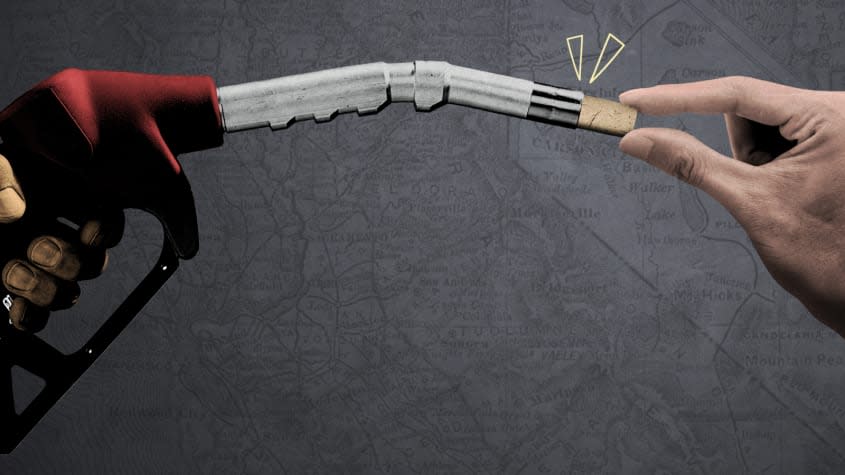California's ban on gas-powered cars, explained

Vroom-vroom is going away in the Golden State.
The state's Air Resources Board on Thursday approved a plan to ban the sale of new gasoline-powered vehicles in the state by 2035. The rules "would set strict deadlines for meeting that goal, forcing automakers to step up production of cleaner vehicles considerably, starting in 2026," The Washington Post reports. More importantly, the move sends "a clear signal to the auto industry that much of the nation's car market will be closed to many kinds of gasoline-powered vehicles" in the not-too-distant future.
California's decision comes as the United States and other countries work to radically reduce the world's carbon emissions over the next few years — and hopefully avoid the worst effects of climate change. That's particularly important in a state where the 15 largest fires in its history have burned just since 2003. "The climate crisis is solvable if we focus on the big, bold steps necessary to stem the tide of carbon pollution," Gov. Gavin Newsom said Wednesday. Can the Golden State put a dent in global warming with its new policy? Here's everything you need to know:
Why does California's policy matter so much?
There are a lot of drivers, driving lots of vehicles: The state makes up 10 percent of the U.S. car market, with nearly 2 million vehicles sold in 2021. With that size comes power, not just in the overall car market but also in the regulatory arena: "California holds the distinction as the only state that can regulate cars, because of a provision in the Clean Air Act that allows it to seek a waiver from federal rules," notes the Los Angeles Times. And even that power is magnified: "More than a dozen other states typically follow California's lead when setting their own auto emissions standards," The New York Times reports. That means the state's decision to ban the sale of gasoline-powered vehicles will have ramifications far beyond its own borders — indeed, it stands to transform the car industry entirely.
Will there be enough electric vehicles to make up for the shortfall?
That's the big question. While the California New Car Dealers Association says it's "all-in" on the transformation, the group has also "raised concerns about the stability of the supply chain," including carmakers' access to raw materials to make batteries, according to the Los Angeles Times. Another concern? Affordability: The average cost of an electric vehicle is $66,000. And even if those cars are able to get on the road, there is a question about whether there will be enough charging stations to power them up. "California now has about 80,000 stations in public places, far short of the 250,000 it wants by 2025," The Associated Press reports.
But Gov. Gavin Newsom (D) plans to launch an aggressive effort to answer those questions. His administration "argues that it is prepared to make the necessary investments to spur the shift to EVs, including $10 billion in vehicle incentives, charging infrastructure, and public outreach over the next six years," The Verge reports. And The Washington Post points out that California's rules come on the heels of a new federal law "that spends tens of billions of dollars to speed up the transition to electric vehicles through generous tax credits for buyers." All of that will be undergirded by what Axios calls "the Battery Belt": A series of "high-tech electric vehicle plants across the South and the Midwest" that are a part of a "rapid build-out of manufacturing capacity for electric vehicles, batteries, and the components and materials required to produce them."
Will the new rules make a difference in climate change?
That's certainly the hope. The state estimates the move will cut greenhouse gas emissions by half by 2040. "Transportation is by far the largest source of global warming emissions in California and passenger vehicles are the single largest source," David Reichmuth writes for the Union of Concerned Scientists. But even such a massive change might not be enough to meet the state's climate goals, he says: "More will have to be done to decrease gasoline consumption, including reducing the need to drive altogether by using transit, biking, and walking."
The move to zero-emissions vehicles should also have other benefits — including, hopefully, a reduction in asthma and other health issues caused by dirty air. One report found that if the U.S. as a whole were to replace gas-powered cars with electric vehicles, the country could save more than 100,000 lives and up to $1.2 trillion in health-care costs.
Will Californians still be able to drive their old gas guzzlers?
Yes. "The mandate will not affect the sale of used cars in California and does not mean car and truck owners have to give up gasoline-powered vehicles they already own," reports the San Diego Union-Tribune. Vroom-vroom might still be around for a while, in other words, but increasingly it will be drowned out by the quiet hum of electric motors.
You may also like
Jimmy Fallon accused of enabling sexual assault of a teenager
Judge orders FBI to release redacted affidavit behind search of Trump's Mar-a-Lago club

